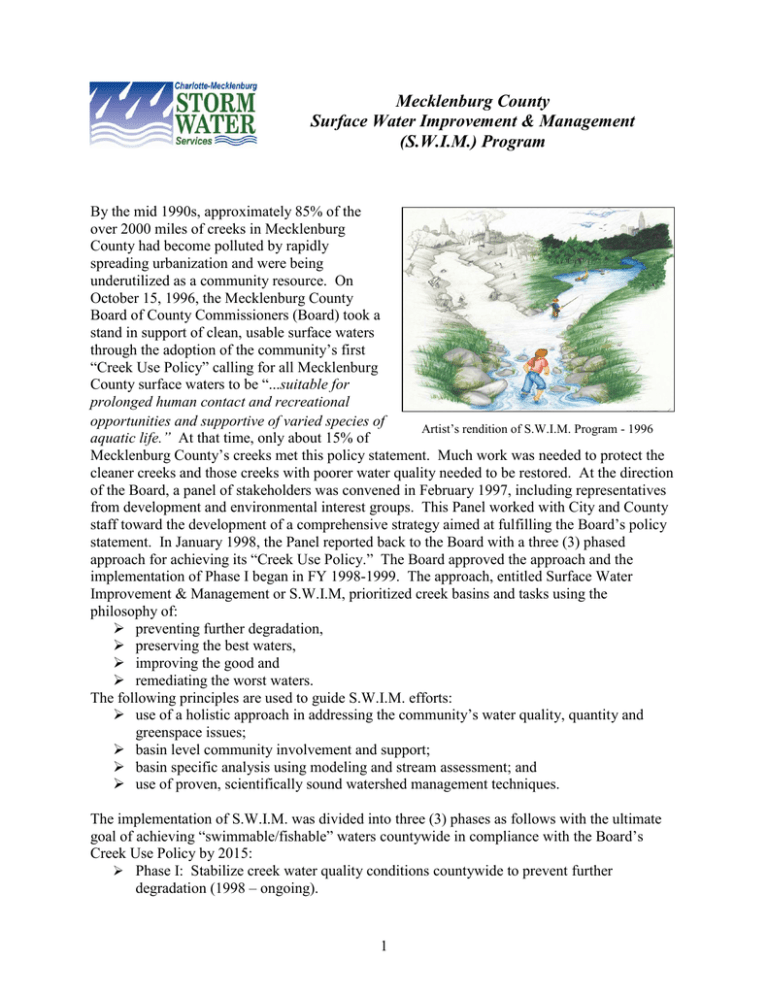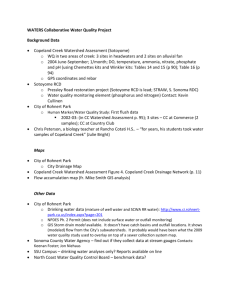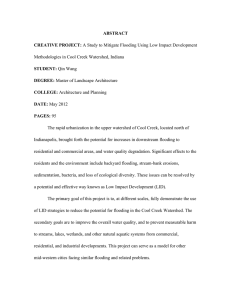Mecklenburg County Surface Water Improvement & Management (S.W.I.M.) Program
advertisement

Mecklenburg County Surface Water Improvement & Management (S.W.I.M.) Program By the mid 1990s, approximately 85% of the over 2000 miles of creeks in Mecklenburg County had become polluted by rapidly spreading urbanization and were being underutilized as a community resource. On October 15, 1996, the Mecklenburg County Board of County Commissioners (Board) took a stand in support of clean, usable surface waters through the adoption of the community’s first “Creek Use Policy” calling for all Mecklenburg County surface waters to be “...suitable for prolonged human contact and recreational opportunities and supportive of varied species of Artist’s rendition of S.W.I.M. Program - 1996 aquatic life.” At that time, only about 15% of Mecklenburg County’s creeks met this policy statement. Much work was needed to protect the cleaner creeks and those creeks with poorer water quality needed to be restored. At the direction of the Board, a panel of stakeholders was convened in February 1997, including representatives from development and environmental interest groups. This Panel worked with City and County staff toward the development of a comprehensive strategy aimed at fulfilling the Board’s policy statement. In January 1998, the Panel reported back to the Board with a three (3) phased approach for achieving its “Creek Use Policy.” The Board approved the approach and the implementation of Phase I began in FY 1998-1999. The approach, entitled Surface Water Improvement & Management or S.W.I.M, prioritized creek basins and tasks using the philosophy of: preventing further degradation, preserving the best waters, improving the good and remediating the worst waters. The following principles are used to guide S.W.I.M. efforts: use of a holistic approach in addressing the community’s water quality, quantity and greenspace issues; basin level community involvement and support; basin specific analysis using modeling and stream assessment; and use of proven, scientifically sound watershed management techniques. The implementation of S.W.I.M. was divided into three (3) phases as follows with the ultimate goal of achieving “swimmable/fishable” waters countywide in compliance with the Board’s Creek Use Policy by 2015: Phase I: Stabilize creek water quality conditions countywide to prevent further degradation (1998 – ongoing). 1 Phase II: Remediate special interest waters (2002 – 2006). Phase III: Restore waters countywide for prolonged human body contact (2006 – 2015). S.W.I.M. Phase I focuses on the basic steps necessary to address the County’s worst pollutants and prevent further water quality degradation. The program has been successful, resulting in measurable improvements to water quality conditions in Mecklenburg County including: 1. Enhancement of efforts to enforce erosion control ordinances and educate the development community resulting in a reduction in sediment levels in some streams by as much as 79%. 2. Enhancement of measures to protect drinking water supply reservoirs by working in close cooperation with developers to improve land development techniques and protect water quality (The Palisades). 3. Establishment of vegetative stream buffers countywide through the adoption of ordinances. These buffers serve to filter storm water pollutants and protect water quality. 4. Enhancement of efforts to address elevated bacteria levels in surface waters resulting in reductions in bacteria counts by as much as 76% in several urban streams. 5. Implementation of water quality modeling techniques for the development of watershed based management plans aimed at maintaining and restoring water quality conditions. 6. Development of automated water quality monitoring techniques, which provide water quality data 24 hours a day, 7 days a week significantly enhancing capabilities for identifying and eliminating pollution problems. This technique was employed in cooperation with N.C. DOT to ensure the protection of Long Creek from sediment discharges from I-485 construction activities and is being expanded to other locations around the County. 7. Improved coordination between City and County staff involved in stream related activities through the development of the Creek Coordination Committee (CCC), which meets monthly to coordinate stream improvement activities. 8. Implementation of stream inventory and assessment activities to better characterize current stream conditions and identify threats to water quality. 9. Increased public education and involvement resulting in a 75% increase in volunteer participation in several water quality restoration initiatives including “Adopt-A-Stream” and “Storm Drain Marking.” S.W.I.M. Phase II was implemented beginning in FY02-03 for the purpose of maintaining and/or restoring water quality conditions in identified special interest watersheds. Efforts focus on the development and implementation of comprehensive watershed management strategies for identifying and eliminating pollution sources to achieve “swimmable/fishable” waters. During its first year of implementation, a prioritization was completed of the 22 watersheds in the county resulting in the selection of two (2) watersheds as the focus of S.W.I.M. Phase II, including McDowell Creek in the northwest that drains to one of the County’s drinking water supply reservoirs and Goose Creek in the southeast that is the home of federally endangered species of freshwater mussel called the Carolina heelsplitter. The highest priority was assigned to McDowell Creek. Significant land development in this watershed has resulted in an increase in non-point source pollutant loads and a significant degradation of water quality conditions, which threatens the county’s drinking water supply in Mountain Island Lake. The U.S. EPA and N.C. Division of Water Quality have also declared McDowell Creek as a “Restoration Watershed” and are coordinating with Mecklenburg County on restoration efforts. In McDowell Creek, a Watershed Management Plan was been developed and implemented on October 4, 2006 for the purpose of restoring water quality conditions. This plan has been used to leverage over 1.3 2 million dollars in State and federal grants for retrofitting best management practices (BMPs) into developed areas to reduce existing pollutant loads. This is matched with an equal amount of local dollars. In February 2003, the Town of Huntersville adopted a low impact development (LID) ordinance to reduce pollutant loads from new development. The use of LID in combination with retrofitting BMPs will ultimately lead to the reduction of pollutant loads in the watershed even as the watershed continues to develop. An extensive water quality monitoring program has been developed and implemented to measure the success of these efforts. Water quality modeling is being used to target restoration efforts so they will have the maximum effect on restoring water quality. In Goose Creek, a Watershed Management Plan was been developed and implemented on October 31, 2009 for the purpose of restoring water quality conditions. In addition, a water quality restoration plan has been developed in cooperation with the municipalities in the watershed for the purpose of reducing bacteria levels in the watershed in compliance with a TMDL approved for the watershed. In addition, the State has developed and implemented a site specific water quality management plan for Goose Creek for the protection of the Carolina heelsplitter. Mecklenburg County has applied for and obtained delegated authority from the State to implement this plan in Mint Hill’s jurisdiction through the watershed post-construction ordinance. The combination of these efforts will work to restore degraded water quality conditions in Goose Creek. An enhanced water quality monitoring program will be implemented in this watershed to measure effectiveness. S.W.I.M. Phase III was implemented in FY06-07 for the purpose of applying the watershed based managed tools developed in Phases I and II to the remaining waters county-wide with the ultimate goal of achieving the Board’s “swimmable/fishable” goal by 2015. S.W.I.M. Phase III will build on the successes of Phases I and II in order to implement countywide maintenance and restoration initiatives beginning in 2008. This implement was made possible through the adoption of post-construction storm water ordinances countywide requiring the use of BMPs for most new developments. These ordinances went into effect on June 30, 2007 in the Towns and on July 1, 2008 in the City of Charlotte. 3





